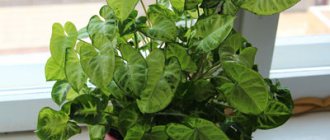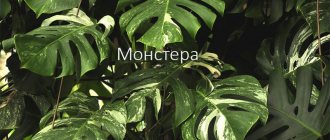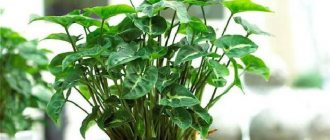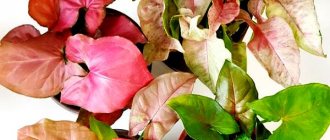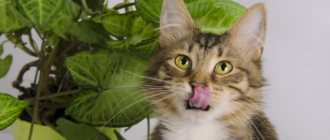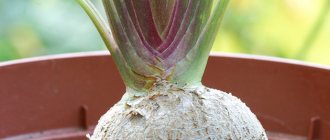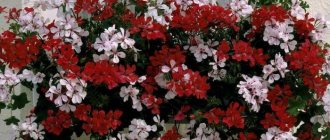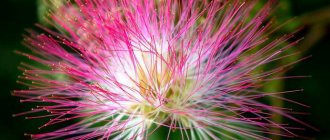The shoots, creeping along the ground or entwining a vertical riser, are densely covered with beautiful large leaves, which have led to the wide popularity of the vine among flower growers.
The syngonium flower is ideal for a home where the owner wants to add some zest and fill the room with a rich palette of green. Following simple rules for caring for a tropical dweller will allow you to create a tropical corner in the interior of a city apartment.
Description of the plant
Liana-like culture belongs to the Araceae family, which has about 3,300 species and about 117 genera .
In the wild, the height of the vine can reach 20 m with a shoot width of 6 cm, and at home it varies from 1.5 to 2 m with a stem diameter of 1-2 cm.
Along the entire length of the shoot there are protruding nodes from which petiolar leaves develop, and a little lower there are aerial roots.
The green leaves are whole, heart-shaped or palmately divided and have different sizes. The location of the relief veins can be in the center or along the edge in the form of an edging. Depending on the variety, the leaf blade can be plain or variegated.
observe the flowering of a tropical vine only in its natural habitat . The beginning is noted at the end of spring, when cream-colored ears bloom, half hidden by a red or pink blanket.
The plant is characterized by cross-pollination, which results in cylindrical or ovoid fruits.
Juicy fruits with a rich aroma are the food of monkeys, who distribute them over large areas. Carefully! The plant is poisonous - work should be carried out with gloves, and children and pets should not be allowed to come into contact with the vine.
Types and varieties of indoor syngonium: photos, names, descriptions of varietal varieties of flowers
In total, there are 35 species in the genus Syngonium. A complete list of syngonium species with Latin names is contained in the database of the Royal Botanic Gardens, Kew. Among them are Syngonium angustatum, Syngonium steyermarkii, Syngonium vellozianum, Syngonium triphyllum, Syngonium chiapense and others.
The most famous is the auricular syngonium ( Syngonium auritum ) - a vine with long clinging shoots, easily forms roots in the internodes, the leaves are glossy and green, young ones are almost arrow-shaped, old ones have a thrice-dissected plate and two ear-shaped small segments at the base. The length of its petioles is three to four tens of centimeters.
Wendland syngonium (Syngonium wendlandii) is considered rarer . A liana with leaves that are velvety to the touch (up to 19 cm in length and up to 8 cm in width), arrow-shaped, with a “tip” divided into three. It grows slowly, the size of the petioles reaches 20-30 cm. The plant's homeland is Costa Rica.
Legleaf (Syngonium podophyllum ) is the third of the syngonium species grown as indoor flowers, the most popular among gardeners. Native to Central America, where its fruits are eaten by the local population, in nature it is an intensively branching vine with flexible and thin shoots covered with large petiolate leaves. The petioles are long, up to 60 cm, the stems are covered with a waxy coating.
There are also variegated varieties of Syngonium podophyllum on sale, which are difficult to identify because they are hybrids. Varietal syngoniums are valued for their exotic coloring. They have somewhat poetic names associated with their external differences. Some varieties of syngonium are described below.
Pixie - plants of this variety are compact, with small green leaves and white spots located along the veins.
Bob Allusion - leaves are round, leathery, olive green in color when young, with noticeable pink veining.
Neon Robusta is a lush bush with bright pink leaves.
Regina Red - Known for its arrow-shaped, bicolor leaves, pink on top and green on the underside. The brightness of their color is directly related to the intensity of lighting.
Silver Moon - leaves are round, emerald in color, in the center there is a milky white spot with jagged edges.
Gold Allusion is a light golden vine with medium-sized leaves with bright pink veins.
Cream Allusion - bushes at the base, leaf color varies from silver to cream, veins are colored pink of varying intensities.
Mango Allusion – soft green foliage with pink centers.
White Butterfly is a variety with elongated, spear-shaped leaves. Their color can be green, milky, yellow, creamy pink. The leaf is covered with a web of light veins.
Panda - many yellow spots on a dark green leaf blade.
Arrow - distinguished by a variegated pattern around the veins, large shoots.
Salad - light green leaves with darker edges.
Silver Pearl - leaves are milky white above, light green below.
Angel baby, Fairy wings are dwarf representatives.
The photo shows decorative varieties of syngonium:
Syngonium has several distribution areas, but each species has an exotic homeland: South America (grows in French Guiana, Guyana, Suriname, Venezuela, Bolivia, Colombia, Ecuador, Peru, Brazil) or Central America (16 species are found in Costa Rica and Panama plants); In addition, some species grow in Mexico and the West Indies (Cuba, Jamaica, Haiti).
The names and differences between the types of syngonium are shown in the photo:
Plant propagation
At home, syngonium propagation is carried out by the vegetative method - cuttings or lateral shoots . It is carried out at any time of the year, but the development of spring and summer cuttings occurs much more intensively. To successfully use this technique, you should follow these steps:
- a part of the shoot with 2-3 internodes and aerial roots is cut off;
- the cutting is placed in warm water with activated carbon or in a soil mixture of sand, moss and peat;
- before rooting, they are covered with a film to reduce moisture loss and create an optimal temperature regime for soil and air - 25-27°C;
- after rooting, the cover is removed;
- seedlings are grown by analogy with the mother specimen.
Advice! Before placing the cutting in the ground for rooting, it is recommended to treat the cut with a root growth stimulator.
This video shows in detail how syngonium is propagated:
Watering rules
As mentioned above, indoor syngonium, like all inhabitants of the tropics, loves moisture. Therefore, the soil should always be moderately moist, but not waterlogged. Lack of moisture leads to a weakened immune system and wilting. And an excess leads to acidification of the substrate and rotting of the root system. How to maintain this difficult balance?
- When watering, make sure that the water begins to flow into the pan. Only then can watering be stopped.
- After watering, wait as long as necessary for the top layer, at least 1.5 cm, to dry completely.
- Moisturizing the leaves is very important for syngoniums, which receive moisture not only from the ground, but also from the air. Therefore, between waterings, wipe the leaves with a soft cloth or moisten them with a spray bottle.
Features of growing indoors
Cultivating a plant in an apartment does not cause problems, but a number of nuances should be studied.
Landing
Syngonium is planted in small containers with drainage holes.
To obtain the splendor of the plant, several shoots are planted simultaneously in one pot.
This variety of vine can be used as a hanging plant if its stems are allowed to hang freely from the pot. Forming a crown will allow you to become the owner of a unique tree.
Advice! To get the shape of a tree, when planting in the ground, you should install a reliable support that will allow the vine to crawl upward.
Transfer
Young specimens are replanted every spring , but as they grow older, the interval between procedures increases. To ensure a successful transplant, the following steps must be followed:
- Place expanded clay at the bottom of the planting container as a drainage layer;
- pour loose and fertile soil with weak acidity on top - a soil mixture of turf, sand and peat;
- Using the transshipment technique to avoid damage to the roots, complete the replanting of the perennial.
Attention! An adult representative of the tropics needs to be replanted after roots appear from the drainage holes.
Care
Caring for the plant is quite simple. The love of gardeners for syngonium is caused by its unpretentiousness, rapid growth and vitality.
- Lighting. The flower requires a long period of diffused light. When placing the pot on the windows on the western or eastern side, we must not forget about protecting the vine from the scorching sun at its zenith.
- Temperature conditions. Throughout the year, with the exception of the winter season, when a decrease to 18°C is permissible, the optimal temperature is in the range from 22 to 25°C.
- Watering and humidity. Tropical liana needs high levels of humidity, systematic watering and spraying. Spraying of shoots is carried out daily with purified water at room temperature. The soil should be watered with the same water at short intervals: the soil should not dry out deeper than 3 cm. Regular moistening makes it easier for the plant to cope with air drought.
- Feeding. Fertilizers in the form of aqueous solutions of special mineral complexes for ornamental plants are applied under the crop at a distance from the stems. Fertilizing can be done from mid-spring to mid-autumn.
- Trimming. Lana has good pruning tolerance. The shoots are pinched for the first time after three pairs of leaves have formed. If necessary, you can shorten any process. If the stem has become too old and bare, then pruning promotes the development of young side shoots.
- Protection from diseases and pests. A native of the tropics has a well-developed immunity to diseases and pests. However, in case of improper care for a long time, it is affected by powdery mildew, and harmful insects such as spider mites, scale insects or mealybugs are observed on the foliage. If detected, protective measures should be taken - a hot shower up to 45C and treatment with the insecticide Actellik or Aktara.
Why Syngonium leaves turn yellow and what to do to treat diseases
Regardless of how to care for a flower, the owner of a syngonium may encounter problems. Pests and diseases rarely affect the plant, but the grower should have an idea of the necessary actions if this happens. This section describes the most common syngonium diseases and their treatment.
What to do if the leaves of syngonium turn yellow?
First of all, you need to find out why syngonium leaves turn yellow: damage by parasites, due to too dry air or lack of light and nutrients. The first can be detected by visual examination of the plant; in the second case, yellowness appears from the tip and edges, the leaf itself becomes flabby and falls off over time; with the third reason, it initially grows small and does not fall off, even when completely yellowed.
The solution to the problem is optional: increasing air humidity, feeding outside the schedule, placing the flower pot in a more illuminated place, or using a phytolamp. These measures are usually enough to stop the syngonium leaves from turning yellow. In case of parasitic infestation, treatment is carried out in accordance with the type of pest; the affected sample must be isolated from the rest.
Benefits, signs and superstitions
In city conditions, syngonium is an excellent solution for apartments and houses. It not only perfectly refreshes the interior, but filters air masses, eliminating the negative effects of hazardous elements.
The plant acts as a stabilizer of the level of humidity and oxygen saturation of the air in the room . But superstitious people often wonder whether it is possible to keep syngonium at home from the point of view of folk wisdom.
Among the people there are absolutely opposite signs and superstitions associated with keeping syngonium at home. According to the interpretation of some, if a person is sick, then the vine will help the owner regain strength and fight a very serious and sometimes incurable disease.
The plant helps strengthen morale and get rid of bad habits. When the owner is tormented by nightmares, it will protect his sleep. In other signs, syngonium is considered a muzhegon: male representatives in the housing where this plant grows do not get along, and the owners face the fate of an old maid. But these are just superstitions that have no justification.
So, keeping such an exotic plant in the house will not cause trouble for the owner, but it will amaze him with its varied colors and have a beneficial effect on health.
Where to put the syngonium?
As a rule, wild Syngoniums are hidden in a tree leaf. Therefore, it is ideal if you have a suitable place on the east and/or west windows. However, even on the north side he will be comfortable. But only in spring and summer! But in the cold season it is better to move it to a warmer and brighter zone. This is especially true in winter, when daylight hours become shorter. If this is not done, the lack of lighting will affect the appearance:
- internodes will stretch out;
- the size of the leaf plate will decrease;
- the leaves will begin to wither for no apparent reason.
How can you help a tropical guest if it is not possible to move him closer to the light? Only with the help of additional artificial lighting! Moreover, the power of the phytolamp must fully meet the needs of your pet.
How to fertilize syngonium?
Naturally, active growth requires regular support in the form of fertilizing. In the warm season, fertilize the plant with liquid complex products intended for ornamental crops every two weeks. Make sure that the fertilizer contains nitrogen, in addition to other microelements. And the cat should categorically refuse calcium.
Possible problems
Ignoring the basic requirements of a plant can cause loss of decorativeness and even death of the plant. Therefore, the sooner the cause of the dejected appearance of the syngonium is identified, the less harm will be caused to the flower by improper care.
The main signs indicating a gardener’s mistakes:
- elongated cuttings and stems, leaves lose contrast of shades - lack of light;
- brown dry spots appear on the leaf plates - burns under the influence of ultraviolet radiation;
- slow growth, the size of new leaves is smaller than previous ones - lack of nutrition or the need for replanting;
- drying of aerial roots - low air humidity;
- sudden yellowing of foliage due to regular watering - low temperature or overflow;
- drying of the tips of the leaves with further yellowing of the entire plate - low air humidity, drying out of the main root.
